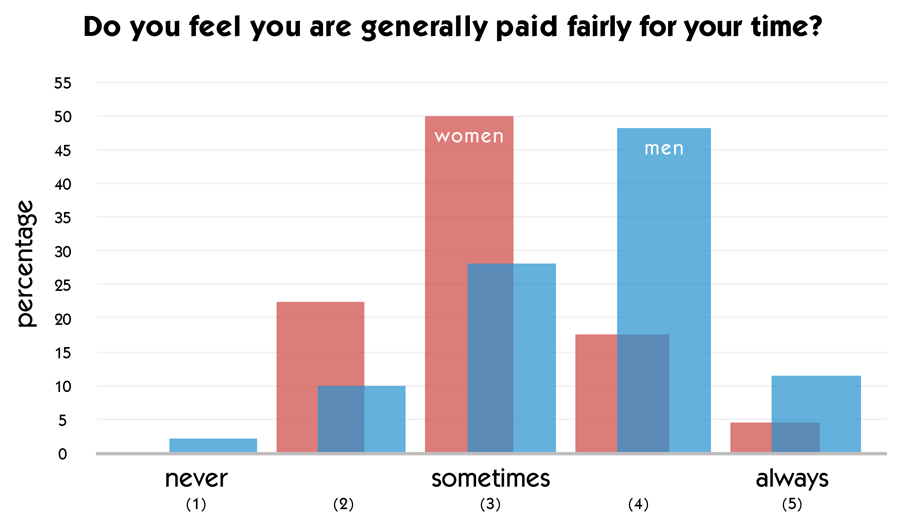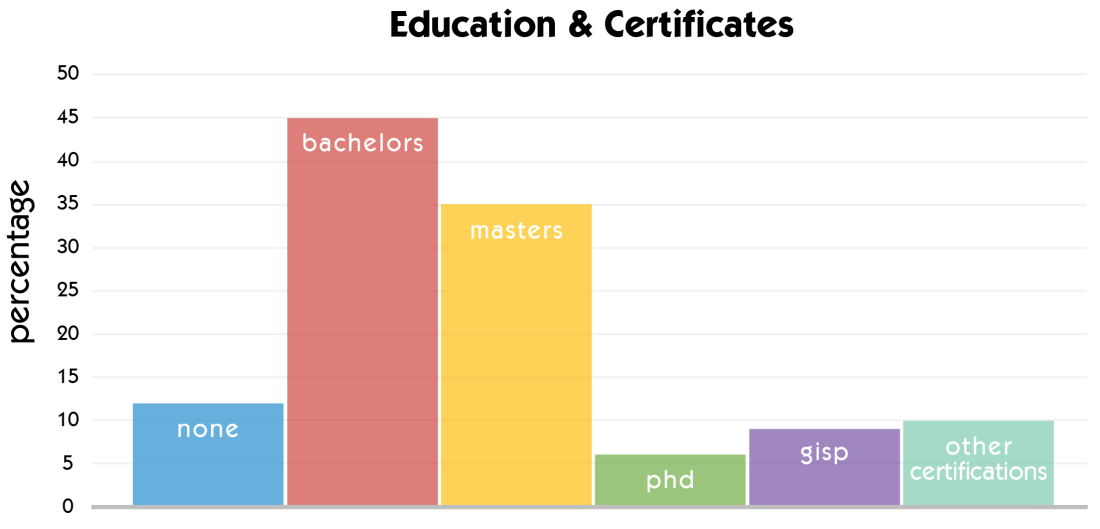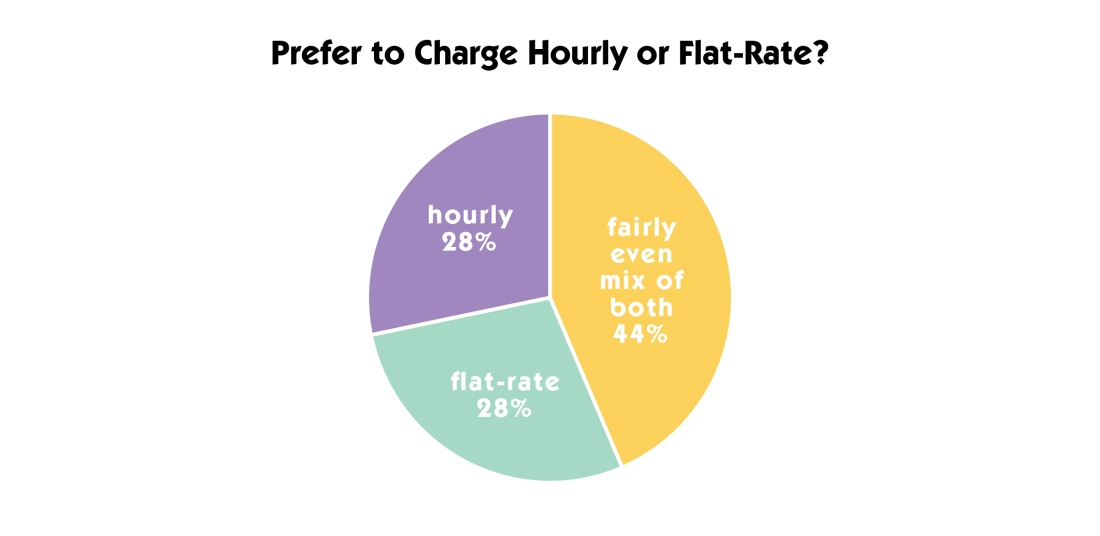A few weeks ago, Aly Ollivierre and I had an email conversation about freelancing, and whether or not the rates we charged were “normal.” Freelancing can be an opaque world, and I’ve tried to bring a little transparency to it in my own way. To help shed a little more light on the cartographic freelance world, we conducted a survey, asking people about their rates and freelancing practices, as well as a few demographic questions. You can see the specific questions we asked by clicking here.
Rather than a straightforward run-down of the results in a blog post, we decided to present them in the context of a conversation with each other, FiveThirtyEight style. Here’s an edited transcript of our conversation. All graphics are by Aly.
Daniel Huffman: I think the bottom-line thing that most people would want to know about the survey is: how much money are people charging on average? That was sort of the impetus for creating this thing. 81 people were kind enough to tell us what their average hourly rate (or equivalent) was, and the average of those numbers was $65/hr.

Which means I really need to start charging more.
Aly Ollivierre: That’s definitely good to figure out, I also split out the numbers by women vs. men. It looks like women are definitely not asking for enough!

People’s average years in the business wasn’t a big difference either to explain that big of a gap: 10.4 for women and 11.7 for the men who answered.
Daniel: When I looked at these data, a voice in the back of my mind said “hey, remember you took a stats class nearly 10 years ago?” I remembered that there are t tests, by which we can demonstrate the statistical significance of these differences. I found an online t-test calculator, and the p-value for the men vs. women average pay was 0.0272, so it’s definitely real, not just due to sample sizes.
I preemptively apologize to Jim Burt, my stats instructor, for everything I have forgotten.
Aly: When asked if they thought they were paid fairly, women’s average answer was 3.1 out of 5 (with 5 being the best), while the average of men was 3.6, so both aren’t super confident that they are being paid fairly.

Daniel: Speaking of fair pay, I did notice a trend in pay rate vs. perceived fairness. I compared perceived pay fairness against how a respondent charged on average. There’s a definite trend, even if it’s not a strong one.

Aly: That’s really interesting to see.
Daniel: Unsurprisingly, people who charged more were generally more likely to say they were paid fairly. Though the numbers are all over the place. There are plenty of people who are unsatisfied, yet charging much more than satisfied people.
Aly: People seem to be all over the board. I looked at education, but didn’t compare it to pricing. Not much of a trend here either, but interesting to visualize.

Daniel: That’s cool to see like that. There are actually lots more folks out there practicing with a degree/certification than I might have expected. I think of cartography as something that a lot of people are self-taught in, but our respondents seem to have a lot of formal training.
Aly: I thought there would be more bachelor’s degrees at least, but I’m not particularly surprised master’s degrees were so high, there’s a lot of pressure these days to get a master’s in order to get paid fairly.
Daniel: And yet, for freelancers at least, it didn’t seem to have a big effect on rates. I created a quick education score (1 point for a Bachelor’s or certificate, 2 for a Master’s, and 3 for Ph.D.) and correlated it with the average pay rate. The correlation was 0.00009, so nothing going on there. I’d be curious if that’s true in the salaried sector.
We also asked people about how long they’d been mapping. I didn’t find a correlation between average charge rates and years of experience. The R-squared was 0.02, so basically nothing. Likewise with age; the R-squared was 0.04.
There’s a surprising (to me) disconnect between age/education/experience and rate. It doesn’t seem to have a big effect whether you’re brand new and self-taught, or whether you’ve got 30 years experience and a master’s degree. Any thoughts as to why that might be?
Aly: That is hard … I feel like my prices have gone steadily up since undergrad as I got additional degrees, certifications, awards, and years of experience. But maybe more experienced folks are not realizing they can or should be charging more?
Daniel: I imagine there can be a hesitancy to raise your rate if you depend a lot on existing clients, so if you set a rate that seemed reasonable 10 years ago, you might get uncomfortable having to tell them you’re increasing it.
Aly: My dad (who owns his own business) checked me on that the other day, saying that my rates should be going up every year, even with the same client, as the cost of living goes up every year.
Daniel: If I were a salaried employee, I’d expect annual cost of living raises from my boss.
One theory I have about the relative immunity of hourly rates to skills/experience/etc. is that I think it’s predicated on the assumption that our clients can assess our resumes. If I got a salaried job, I’d expect an employer to look at my background and pay me with an understanding of my abilities. But I think most freelance clients don’t think that deeply about it. I’m not sure most of my clients know, when they hire me, whether I’m good at my job or not.
Aly: That’s a good point, I do make sure that my LinkedIn is up to date and try to remember to get recommendations for my freelance work on there as I can.
Daniel: That’s a good thought. I imagine hearing from another person, “Oh, she’s very good and thought of all these things we didn’t” would be helpful.
Aly: I agree, but it feels weird to put it on my website, so I just try and link people back to my LinkedIn.
Did you look at all at rates based on full time or part time?
Daniel: I did. 32% of our respondents indicated they were full-timers, so part-timers are the majority, if our sample is any fair indication. Part timers indicated an average rate of $68/hr, while full-timers said they charged $61. The p-value was 0.38, though, so this difference isn’t really statistically significant. This is something I’ve heard people wonder about — whether part-timers have the flexibility to charge more because they can “afford” to lose out on projects. Which kind of ignores the fact that part timers often still rely quite strongly on the mapping income even if it’s not their only gig. I also looked at gender and part-time.

Aly: I’m not particularly surprised that there were more part-timers, I think it’s still hard to find enough work to fill up a full-time schedule and be able to afford insurance/rent/etc.
The part-time vs. full-time conversation is interesting. A lot of the comments reiterated my feelings that you have to accept projects on a sliding scale based on the client and that being full-time vs part-time doesn’t necessarily mean you can charge more … who your clients are is more important.
Daniel: A lot of people gave feedback along those lines. Some comments that respondents said we could share:
“I change my rate based on my client. If it’s a nonprofit or NGO, I typically work for less”
“If i’m working for a non-profit that I support the mission of, i’m willing to take a lower rate.”
“Sometimes I charge more based on willingness/ability to pay rather than the difficulty of the work”
Aly: There were some other helpful comments in there as well: like,
“I always have a clause in the contract that extensive revision or modifications to the scope work will be billed separately at a rate of X per hour.”
This is advice that I should take myself as extensive revisions is what tends to hurt me on flat rate projects.
Daniel: I have also gotten hammered on some of those flat rate pieces. I sometimes come back and ask for more, but I’m one of those people who doesn’t work with a contract very often. And our survey suggests that folks are pretty split on this, so I guess I’m not alone in not having one.

Any contracts I sign are usually ones offered by large organizations that have boilerplate ones.
Aly: I was surprised how many people said they do! I’m lucky that most of my clients are personally recommended to me or small-scale so I haven’t felt the need to write up a contract, but I definitely think I should put more thought into that. I wonder if anyone who always uses one might be willing to share a copy. I wouldn’t even know where to start to make sure it covers everything that it should.
Daniel: I think that would be helpful. I’ve looked online for various bits of legal language before, but it always ends up getting adapted to be more map-and-illustration specific. Oftentimes it feels like too big of a hassle for the small bits of work that I do. If someone’s paying me $250 for some small greyscale pieces for their short-run university press book, I start to weigh up in my head the amount of time it will cost me just to get a contract set up, vs. the amount I’m being paid.
One piece of advice on contracts that I’ve received from Tanya Buckingham (who is my mentor in so many ways): add kill fees. So that if the work gets cancelled part way through, it’s clear how much money will be owed to you, even if it’s not the full amount.
Aly: I also liked the comment:
“I usually charge a flat rate with an additional line in the estimate for changes beyond the first (or sometimes second) round of revision. Additional client revisions are billed at $100/hour.”
I never would have thought about charging a higher flat rate for revisions, but I definitely see the appeal, oftentimes I spend more time on revisions than on making the map itself.
Because as another respondent noted:
“Maps are more of an analytical domain than the typical graphic design project involves. As such it can be really difficult to safely arrive at a mutual understanding without essentially making, then iterating, maps to show as a “mockup” while simple “changes” are full re-builds with variable effort. External examples were helpful, but I found the customers’ mind’s eyes were frequently quite different from cited examples in critical (and time-consuming) ways.”
Daniel: Absolutely. I think a lot of clients don’t quite know what it’s going to look like when they hire me, or they don’t quite know what they want. The various drafts are an exploration process.
And this ties in with the previous quote about contracts allowing a set number of revisions. Locking that down early is good. I have occasionally done that (verbally, by email), but perhaps not as often as I should.
Along those lines, though, I do tend to raise my rate if I’m already busy with other work and sort of don’t feel like taking something else on. I factor my mental stress into the rate a bit, so that it will be compensated monetarily, or they’ll just say no and I won’t need to deal with them.
Aly: It’s really important to take your own mental stress into account when assessing whether or not to take on a project, especially when this work is alongside a full-time job. As one of the respondents noted:
“I require a $100/hour minimum because I have a full time job and I don’t want or need to add extra stress unless the client is serious and the project is worthwhile.”
Daniel: The last bit of statistical analysis I did on the survey was to compare countries a bit. Most of our respondents were from the United States (79%) which, given the language of the survey and our professional networks, was not surprising. But we had a fair number of folks from Europe answer, as well (12%). I lumped them all together so that we had enough to compare. In the US, the average hourly rate was $64, and it was $65 in Europe, so not much going on there.
Also: my apologies to folks in other countries. We had few enough responses from some places that I couldn’t break those out separately, but your answers were still valuable for the other numbers we calculated above!
Aly: There’s not much of a market for freelance cartography-specific work in the other parts of the world I’ve lived in.
Daniel: That’s an interesting thought: is the market actually mostly US-centered? I thought maybe it was just a bias in our sample, but maybe if we could count every mapmaking freelancer, we’d actually find that a lot of them are in the US?
In your time in the Caribbean did you encounter other freelancers there? Or in other countries you may have lived in?
Aly: I haven’t, not in the countries that I have lived in while I was at the point in my career that I was freelancing (and paying attention to others that did as well). I worked with a fellow student subcontracting on a project from a professor in Trinidad, so a few of my professors from my master’s program did take on some side work.
Daniel: I’d be curious for our readers in other countries to comment on the robustness of their freelance cartographic scenes.
Any other things you saw in the survey that interested you, or surprised you? I think that’s mostly what I’ve extracted from it.
Aly: That’s mostly what I gathered from it as well, I hope we can get a discussion of the results started with the carto-audience, I’d be interested to hear other people’s thoughts.
Daniel: Absolutely. I think people will be excited. Even just the bottom-line understanding that the average going rate is about $65/hr is extremely useful for all of us floating, disconnected out there who don’t know where to begin valuing our services.
I’m also beginning to learn from the survey how undifferentiated the market is as far as skills and experience, and I think it’s useful for all of us to think about ways to educate clients as to how much we’re worth. If they can’t judge our resumes, maybe we (or testimonials from other clients) can help them understand.
Aly: I’d also be interested to break that down even more into a price range for small-scale orgs or NGOs vs a price range for larger or corporate clients as well as how that average rate changes more clearly based on experience (which didn’t show up with much of a trend in the survey)
Daniel: Sounds like we have some thoughts for future surveys. Perhaps down the line, especially after we see what new questions this one prompts in people’s’ minds, we can do some more.
Thanks to everyone who took our survey! Aly and I hope that you will all find this enlightening, and that it will lead all freelancers to feel more comfortable and confident in setting rates.
This is a draft of the post, which was accidentally mailed out before it’s finished, so right now it’s password protected. The real thing should go up in the near future. Sorry for the confusion!
Reblogged this on Schwartz spatial and commented:
Sorry folks for the delay in the What is Spatial post but i just ran across this in my feed and decided to share it. Because if you have an interest in GIS, getting into it professionally, or know some who is doing that this would be a handy bit of information on the nature of the market.
And that is geo-education too.
Good read. Maybe we should look at what type of mapping we typically do. I normally work on projects that take two or more months to complete. That’s why it is important for me to get a service agreement (although it takes a day or two to prepare), that outlines everything that I can think of and explains extensive revisions. I don’t do that for a map of a 5K race route in grey scale.
kru